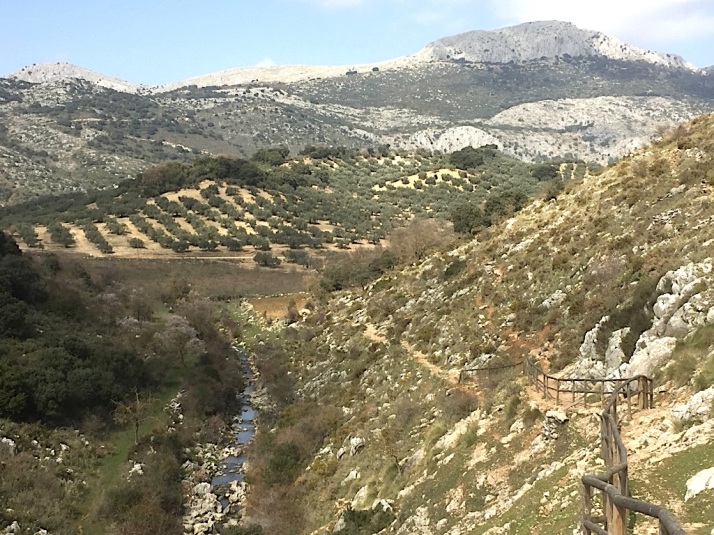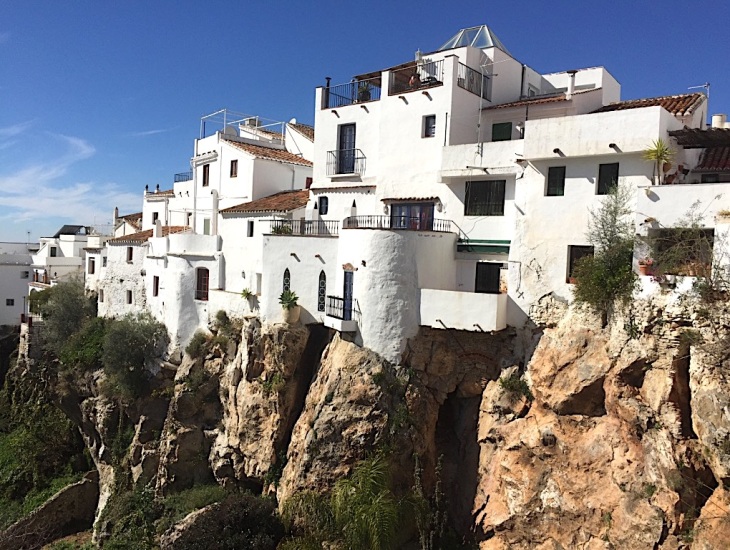Out in the countryside to the east of Málaga city we found the Axarquía (Ax-are-KEY-ah) region, a refreshingly authentic part of southern Spain. To explore this bucolic land of almond, olive, and vine planted hillsides, we made four separate day-trips to Frigiliana, Cómpeta, Alfarnate, and Riogordo, all pretty whitewashed villages from the Moorish era.

Hilltop Moorish Castle, Frigiliana
The Moors were nomadic Muslim people from North Africa that occupied southern Spain between 711 and 1492 AD. The nearly eight centuries of Moorish influence in the Axarquía left an especially strong impression, most notably in the restored town of Frigiliana.

Frigiliana: “The Prettiest Village in Andalucia”
Frigiliana is exceptionally well-maintained, with freshly whitewashed walls, neatly painted pastel doors, well-tended flower pots, and spotless cobblestone alleyways. Given its preserved Moorish architecture and pristine condition, Frigiliana was voted by the Spanish tourism authority as “the prettiest village in Andalucia”.

Moorish Irrigation Channel, Cómpeta
The Moors also designed and installed an ingenious irrigation system of water wells, channels, and reservoirs to support their agricultural efforts throughout the Axarquía. To observe this still-active water delivery system, we visited the village of Cómpeta, and followed a well-worn rural footpath to the neighboring hamlet of Canillas de Albaida.

Tiled Pictorial of Traditional Muscatel Wine Making, Cómpeta
Remarkably, the irrigated terraced slopes of poor basic soils around Cómpeta yield an abundance of sugary Muscat grapes. The grapes are hand harvested, and most are dried in the sun to produce moist and meaty Málaga raisins. The remaining are squeezed to make Muscatel, a pleasantly sweet dessert wine.

Winter Walk between Alfarnate and Alfarnatejo
Another exceptional cultivation of the region is the exquisite Marcona almond. Around Málaga city, street vendors sell the skinless and lightly salted treats in white paper cones. To see the almond trees in full bloom, we went for a winter walk between Alfarnate and Alfarnatejo, the two highest villages of the Axarquía.

Almond Trees in Bloom, between Alfarnate and Alfarnatejo
Stepping off the bus at an elevation of 3,000 feet (915 m), the air was noticeably cooler. On the brisk hike through the verdant countryside, the profuse pink and white almond blossoms and steely grey dolomitic outcrops stood out against the canvas of olive-green.

Olive Orchard above Riogordo
Grey-green grids of twisted olive trees envelop the Axarquía hills. Because Spain is the world’s leading producer and exporter of olives and olive oil, we came to the town of Riogordo to walk through its olive orchards and attend an olive oil grinding festival.

Taking a Break from the Daily Grind, Riogordo
The small festival was really just an expanded open house for the local ethnological museum and an excuse to partake in some sensible day-drinking. Besides olive and olive oil tasting, the festival also included an olive pit spitting contest and a demonstration of traditional olive grinding using a blindfolded mule.

Arab Accents in Alfarnate
From the silly to the sublime, our trips into the countryside east of Málaga were welcome getaways from the crowded unnatural city and superficial tourist beaches. In the original ancient villages, bona fide hill and mountain landscapes, and genuine local delicacies, we discovered the real deal in authentic Axarquía.

Esther and Almond Street Vendor, Málaga
Feature Image: Clifftop dwellings of Cómpeta

Prettiest village is right! Can you imagine living in such a place? Drop a piece of trash and you ruin the whole aesthetic. (I wonder if they’d fine you?)
“Taking a Break from the Daily Grind”… 😆
LikeLiked by 2 people
Hey Christi, Frigiliana is a nice place to visit, but I would never want to live there. The competition to become the “prettiest” must have been intense, and the town leaders undoubtably use extreme peer pressure and even fines to stay #1. An ongoing problem for us walkers in southern Spain is the amount of dog poop on the sidewalks. In Frigiliana, even the dogs are lambasted for besmirching the town’s image.
LikeLiked by 2 people
I really enjoyed this post. Lovely to hear about these gorgeous white pueblos. Brian and I would love to visit this area. Do you think we can get our motorhome up there? Are the roads good? We seen lots of olive and almond trees on our drive from Zaragoza to Peniscola today. The almond trees are so pretty all dressed in pink. Thank you for your lovely photos.
Ps. Can I also suggest Caminito Del Rey? Near Malaga. I have not done yet, but I am very keen to do it when we head that way.
LikeLiked by 1 person
Thanks, Gilda. You and Brian are really getting around in your house-on-wheels. I am sure you could access the Axarquía in your motorhome. I would just try to avoid driving inside the towns themselves. I would hate to see you put a scratch on your new ride. Thank you for the Caminito Del Rey suggestion. With Esther’s school schedule and our limited time remaining in Málaga, we may not have the opportunity to go there. I hope you do, and write all about it. Happy and safe travels!
LikeLiked by 1 person
I agree with CJ: apparently no one gets out of line in Frigiliana and keeps their home unkempt. It looks absolutely clean and orderly. Even the almonds look clean; don’t touch! 🙂 – Marty
LikeLiked by 1 person
Hey Marty, We were just about to grab a handful of almonds when we saw the vendor’s sign. That would have been a major faux pas. Of all the towns we visited in “authentic Axarquía”, Frigiilana was the most contrived. It truly was perfectly made up with not a hair out of place. Can you image someone there painting their home granny smith apple green?
LikeLiked by 1 person
I was thinking when I read your descriptions and looked a the pictures how similar it is to condo communities and their strict rules about paint and even door coverings. 🙂
LikeLiked by 1 person
Maybe even more strict, Marty. The village is so dependent on tourism that any violations might cause them to lose their “prettiest” status and negatively impact their bottom-line.
LikeLiked by 1 person
I love how, wherever you and your wife go, you manage to engage in the authentic, local culture! The moorish village looks so pretty! And I’m assuming they don’t usually still use mules to grind the olives? That was just a demonstration, right?
LikeLiked by 1 person
Rest assured, Ann. From all indications, mules are no longer used in the olive oil industry. “Our” mule was just part of a one-day exhibition, did not appear overworked or stressed out, and seemed to enjoy all the attention from the onlookers. Like our adventures in the Axarquía, Esther and I do attempt to reach the less-visited parts of our travel destinations. They can sometimes be difficult to access by public transportation, but usually worth the effort in cultural enrichment.
LikeLiked by 1 person
I thought that was it, and I’m sure the mule was fine. And thank you for sharing the less-visited parts of your journeys on your blog! It’s very interesting and I learn a lot from your posts!
LikeLiked by 1 person
I didn’t realize the Moors had been around that long, or maybe I just forgot. Contrived or not, it looks like a pretty village, at least your photos suggest that. I wonder why, considering I’ve read almonds take a lot of water to grow, the trees seem to show up in warmer, dryer climates?
LikeLiked by 1 person
Thanks for the really interesting question, Dave. I read that it takes one gallon of water to produce one almond. I used to travel to the California Central Valley for business and will never forget the endless fields of blooming almond orchards. Of course, the water irrigation system required to support agriculture in California is massive. The hot and dry area around Málaga is laced with much smaller but impressive irrigation systems too. It does take a lot of water to produce almonds, but about six times less than beef per unit of protein.
LikeLike